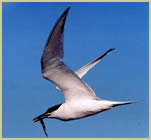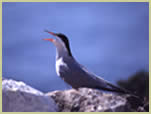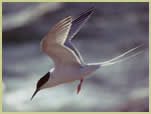|
Terns
Three species of tern breed regularly
at Cemlyn. The numbers of Sandwich
Tern nesting on the islands
in the lagoon have been going up in recent years, making the
colony one of the largest in the country.
There were over 1000 nests in 2005, and a good percentage
of chicks fledged. The Sandwich Terns generally nest in dense
groups, and seem to benefit from being close to groups of
nesting Black-headed Gulls,
which react aggressively to the threat of a predator, while
the Sandwich Terns sit tight. Common
Terns nest in sparser groups
and smaller numbers on the islands, as do the very similar
Arctic Terns,
which make an epic journey from the southern to the northern
hemisphere and back every year - the longest migration of
any bird.
One of Britain's rarest seabirds, the Roseate
Tern was a former breeder at
Cemlyn, and is still sometimes seen on passage, as are other
rarities like Little Tern
and Black Tern.
A vagrant Sooty Tern
caused great excitement when it visited the colony in the
summer of 2005.
The tern colony is the main focus
of conservation work at Cemlyn. Because of disturbance at
their traditional breeding areas, due to increased coastal
access and development, terns have declined historically in
Britain, so sites like Cemlyn, which still hold healthy populations,
are a precious and nationally importance resource.
Two wardens are employed by NWWT
every summer, to monitor and protect the terns. As well as
dealing with disturbance and predation, they record the numbers
of nests, the fledging success of chicks, and also the kinds
of fish being brought in by their parents. Feeding studies
are important because availability of fish, especially the
terns ideal food, Sandeels, can be the key factor in a successful
breeding season. The combined results of warming seas and
commercial overfishing of Sandeels around Shetland for example,
have had a disastrous effect on the productivity of Arctic
Terns there.
All terns are migratory. Sandwich
Terns are usually the first to be seen, in late March and
April, with the bulk of breeding adults of all species arriving
on site in May. June and July are the busiest months for the
terns, and a good time to visit the reserve, the lagoon islands
becoming a hive of activity.
By mid-August, the majority of chicks should have fledged,
and be ready to join their parents on the journey south to
their wintering areas - the coast of West Africa in the case
of most Common and Sandwich Terns, even further south for
Arctics. |













